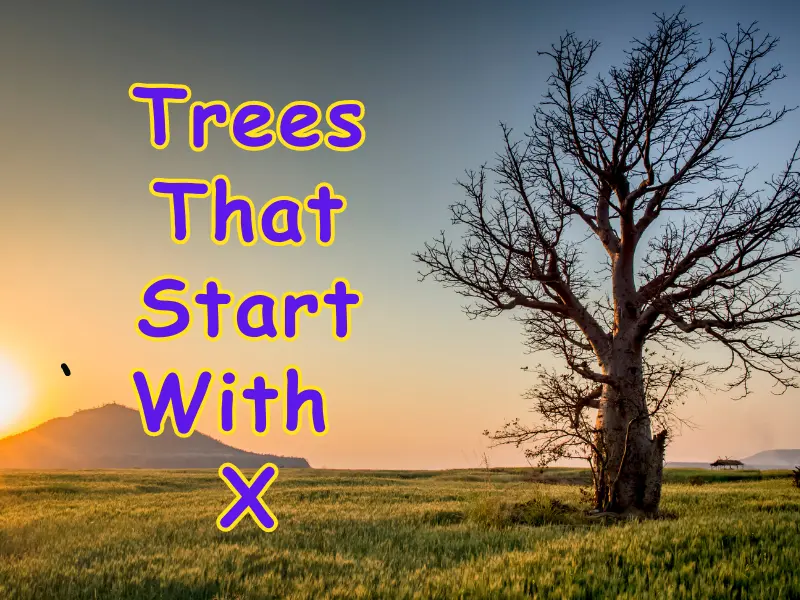
Introduction
Nature never ceases to amaze us with its diverse and captivating flora, and trees are no exception. While most people might struggle to think of tree names starting with the letter “X,” there are indeed a few fascinating tree species that fit the bill. In this beginner’s guide, we’ll journey into the realm of botanical wonders and discover some intriguing trees that start with the enigmatic letter “X.” Trees That Start With X.
Ximenia Americana (Seaside Plum)
Our journey through the botanical world of trees starting with “X” begins with the Ximenia Americana, commonly known as Seaside Plum. This small deciduous tree is native to the tropical and subtropical regions of the Americas. Its distinctive feature is its edible fruit, which resembles a plum and is widely used in traditional medicine due to its potential health benefits. Trees That Start With X.
Xanthoceras sorbifolium (Yellowhorn)
Transitioning further into the world of unique trees, we encounter Xanthoceras sorbifolium, also known as Yellowhorn. This deciduous tree hails from China and is admired for its showy white flowers that bloom in spring. Its seeds are equally remarkable; they contain oil that has potential for biodiesel production.
Xylosma Congestum (Shiny Xylosma)
Shiny Xylosma, scientifically known as Xylosma congestum, is an evergreen tree that originates from Mexico and Central America. This tree boasts glossy, dark green leaves that provide an attractive backdrop for its small, inconspicuous flowers. Its tolerance to various soil types and its ability to thrive in both sun and shade make it a popular choice in landscaping. Trees That Start With X.
X Cupressocyparis leylandii (Leyland Cypress)
Venturing into the realm of ornamental trees, we come across X Cupressocyparis leylandii, commonly referred to as Leyland Cypress. This fast-growing hybrid evergreen is a favorite for creating privacy screens and windbreaks due to its dense foliage. Its elegant, columnar shape adds a touch of sophistication to any landscape. Trees That Start With X.
Xanthostemon chrysanthus (Golden Penda)
Traveling across continents, we discover Xanthostemon chrysanthus, also known as Golden Penda. This vibrant tree originates from Australia and showcases stunning clusters of golden-yellow flowers, which attract birds and insects alike. Its aesthetic appeal makes it a sought-after choice for gardens and urban landscapes. Trees That Start With X.
Ximenia caffra (Sourplum)
Returning to the genus Ximenia, we encounter Ximenia caffra, commonly referred to as Sourplum or Wild Plum. This small tree is native to southern Africa and is valued for its tart, plum-like fruits that are used in various culinary applications. Additionally, its hard, dense wood is used for crafting and woodworking.
Xylocarpus granatum (Cannonball Mangrove)
Stepping into the world of coastal ecosystems, we meet Xylocarpus granatum, also known as Cannonball Mangrove. Native to tropical regions, this tree plays a crucial role in stabilizing shorelines and providing habitat for various marine organisms. Its distinctive cannonball-like fruit floats in water, aiding in dispersal.
Xylosma flexuosa (Flexible Xylosma)
Our journey takes us to Xylosma flexuosa, commonly known as Flexible Xylosma. This evergreen tree, native to China and Japan, displays wavy, leathery leaves and small yellow-green flowers. Its adaptability to different conditions, including urban environments, makes it a versatile choice for landscaping.
Xylosma senticosum (Lemonwood)
Lastly, we explore Xylosma senticosum, also known as Lemonwood. Native to New Zealand, this small tree is famous for its lemon-scented leaves and attractive clusters of white flowers. Its wood is highly prized for its durability and is often used in crafting intricate items.
Conclusion
In the vast tapestry of nature, even the seemingly elusive letter “X” finds its place through these captivating trees. From the shores to the mountains, these trees remind us of the incredible diversity our planet holds. Whether for their beauty, utility, or environmental contributions, these “X” trees are a testament to the wonders of the natural world.
FAQs
1. Are all trees that start with “X” exotic species? No, while some trees are native to regions outside North America or Europe, others, like Xylosma flexuosa, can thrive in urban environments and gardens.
2. Can I grow Xylocarpus granatum in my garden if I don’t live near a coastline? Xylocarpus granatum, or Cannonball Mangrove, is adapted to coastal conditions and may not thrive in inland gardens. However, you can explore other trees that suit your region.
3. Are the fruits of Ximenia caffra safe to eat? Yes, the fruits of Ximenia caffra, or Sourplum, are edible. However, they are known for their sour taste and are often used to make jams and sauces.
4. Can Leyland Cypress (X Cupressocyparis leylandii) withstand cold climates? Leyland Cypress is well-suited for mild to moderate climates. While it can tolerate some cold, extremely harsh winters might negatively affect its growth.
5. Are Xylosma species prone to any specific pests or diseases? Xylosma species, including Shiny Xylosma and Flexible Xylosma, are generally hardy, but they can occasionally be susceptible to aphids or fungal diseases. Regular care and maintenance can help prevent these issues.
6. How large does Xanthostemon chrysanthus (Golden Penda) grow? Golden Penda can reach heights of 20 to 30 feet (6 to 9 meters) with a spread of about 15 to 20 feet (4.5 to 6 meters).
7. What is the ecological importance of Xylocarpus granatum (Cannonball Mangrove)? Cannonball Mangrove plays a vital role in coastal ecosystems by preventing erosion, providing habitat for marine life, and supporting overall shoreline stability.

